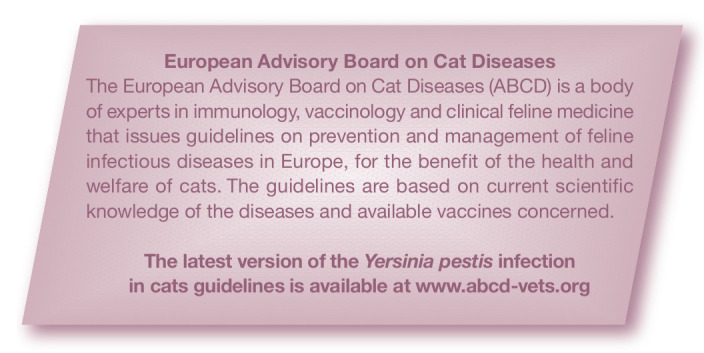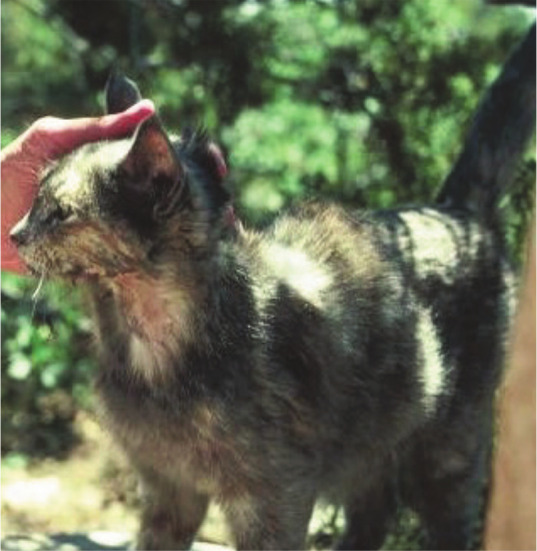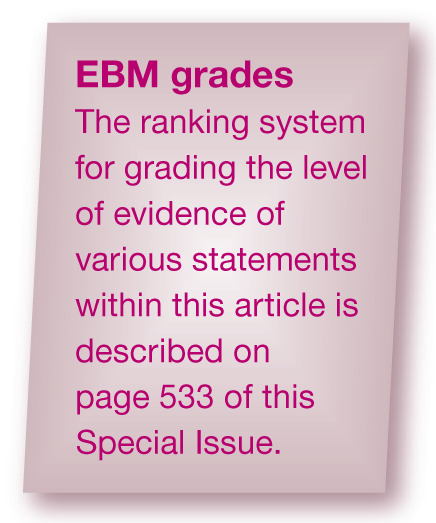Abstract
Overview: Plague, the medieval ‘Black Death’, is caused by a Gram-negative coccobacillus, Yersinia pestis, which also infects cats. As in people, it is transmitted from rodents through flea bites; it occurs in Asia, Africa and the Americas in flea-infested regions, all year round, and where rodent reservoirs are abundant. A poor prognosis is associated with high fever, and the pulmonary and septicaemic forms. Antibiotic therapy, flea control and avoidance of rodent contacts have made this infection manageable.
Agent properties
Yersinia pestis, a Gram-negative coccobacillus that belongs to the family Enterobacteriaceae, is the causative agent of plague, a rare but often fatal zoonosis of historical significance in Europe (Black Death). Y pestis is resistant to low temperatures and freezing, and sensitive to high temperatures. 1
Epidemiology and vectors
Plague occurs in Asia, Africa and the Americas in semi-arid areas, where fleas are active all year round and rodent reservoirs are abundant. Epizootics in rodents expose humans and domestic animals to plague. 1 Transmission occurs via flea bite or ingestion of infected rodents or lagomorphs. 2 Less common is transmission through mucous membranes, skin lesions or inhalation of infected aerosols from individuals suffering from the pulmonary form. Xenopsylla cheopis fleas that have fed on bacteraemic rodents are efficient transmitters of the infection – for more than 1 year – to nearly all mammals. However, not all flea species are efficient vectors: Ctenocephalides species are considered poor transmitters of plague. 1

Clinical signs
The prognosis for a cat with high and continual fever is poor. 3 The bubonic form is most common and usually involves the mouth (necrotic stomatitis) and mandibular or sublingual lymph nodes when the infection is acquired by preying on infected rodents; drainage of abscesses is a favourable prognostic factor (Figure 1). Septicaemic forms may involve any organ (mainly the lungs), with a clinical presentation of endotoxic septic shock and death in 48 h. The pulmonary form has the worst prognosis and may derive from one of the previous forms or, rarely in the cat, occur as the primary form.2,4 The overall mortality rate is about 50%. 1
Figure 1.

Cat recovering from plague and submandibular bubo. Image courtesy of the Centers for Disease Control and Prevention, www.bt.cdc.gov; http://emergency
Diagnosis
Clinical suspicion is confirmed by cytology on smears from draining lesions, where only Gram-negative organisms with a bipolar safety-pin shape are seen. 1 Bacteria can be isolated from the tonsils, blood or other infected tissues by reference laboratories; transportation is subject to class II precautions (hazardous agents). A fourfold rise in antibody titre on serology confirms an acute infection [EBM grade III]. 1
Treatment
Gentamicin is the drug of choice; doxycycline is used in less severe cases (bubonic form) or for prevention [EBM grade III]. 5

Footnotes
Funding: The authors received no specific grant from any funding agency in the public, commercial or not-for-profit sectors for the preparation of this article. The ABCD is supported by Merial, but is a scientifically independent body.
The authors do not have any potential conflicts of interest to declare.
Key Points
Plague is a zoonosis with a fatal outcome, if left untreated.
Plague is caused by Y pestis, a Gram-negative coccobacillus that is resistant to low temperatures.
Plague occurs in Asia, Africa and the Americas in areas where fleas are active all year round and rodent reservoirs are abundant.
Transmission occurs via flea bites or ingestion of infected rodents or lagomorphs; not all flea species are efficient vectors.
Different clinical forms are found; a poor prognosis is associated with high fever, and the pulmonary and septicaemic forms.
The bubonic form is common and manifests with necrotic stomatitis.
Drainage of abscesses is a favourable prognostic factor.
Overall mortality is about 50%.
Diagnosis is confirmed by cytology on smears from draining lesions or by serology.
The bacterium can be isolated from tonsils, blood or other infected tissues by reference laboratories; transportation is subject to class II precautions.
Gentamicin is the drug of choice; doxycycline is used in mild cases (bubonic form) or for prevention.
Prevention is based on flea control and avoidance of contact with mice.
Veterinarians, technicians and owners of diseased cats are at risk.
References
- 1. Chomel B. Plague. In: Greene CE. (ed). Infectious diseases of the dog and cat. 4th ed. Philadelphia: WB Saunders, 2012, pp 469–476. [Google Scholar]
- 2. Eidson M, Thilsted JP, Rollag OJ. Clinical, clinicopathologic, and pathologic features of plague in cats: 119 cases (1977–1988). J Am Vet Med Assoc 1991; 199: 1191–1197. [PubMed] [Google Scholar]
- 3. Gasper PW, Barnes AM, Quan TJ, Benziger JP, Carter LG, Beard ML, et al. Plague (Yersinia pestis) in cats: description of experimentally induced disease. J Med Entomol 1993; 30: 20–26. [DOI] [PubMed] [Google Scholar]
- 4. Carlson ME. Yersinia pestis infection in cats. Feline Pract 1996; 24: 22–24. [Google Scholar]
- 5. Orloski KA, Lathrop SL. Plague: a veterinary perspective. J Am Vet Med Assoc 2003; 222: 444–448. [DOI] [PubMed] [Google Scholar]
- 6. Craven RB, Maupin GO, Beard ML, Quan T, Barnes AM. Reported cases of human plague infection in the United States 1970–1991. J Med Entomol 1991; 30: 758–761. [DOI] [PubMed] [Google Scholar]
- 7. Gage KL, Dennis DT, Orloski KA, Ettestad P, Brown TL, Reynolds PJ, et al. Cases of cat-associated human plague in the Western US, 1977–1998. Clin Infect Dis 2000; 30: 893–900. [DOI] [PubMed] [Google Scholar]
- 8. Gould LH, Pape J, Ettestad P, Griffith KS, Mead PS. Dog-associated risk factors for human plague. Zoonoses Public Health 2008; 55: 448–454. [DOI] [PubMed] [Google Scholar]
- 9. von Reyn CF, Weber NS, Tempest B, Barnes AM, Poland JD, Boyce JM, et al. Epidemiologic and clinical features of an outbreak of bubonic plague in New Mexico. J Infect Dis 1977; 136: 489–494. [DOI] [PubMed] [Google Scholar]



